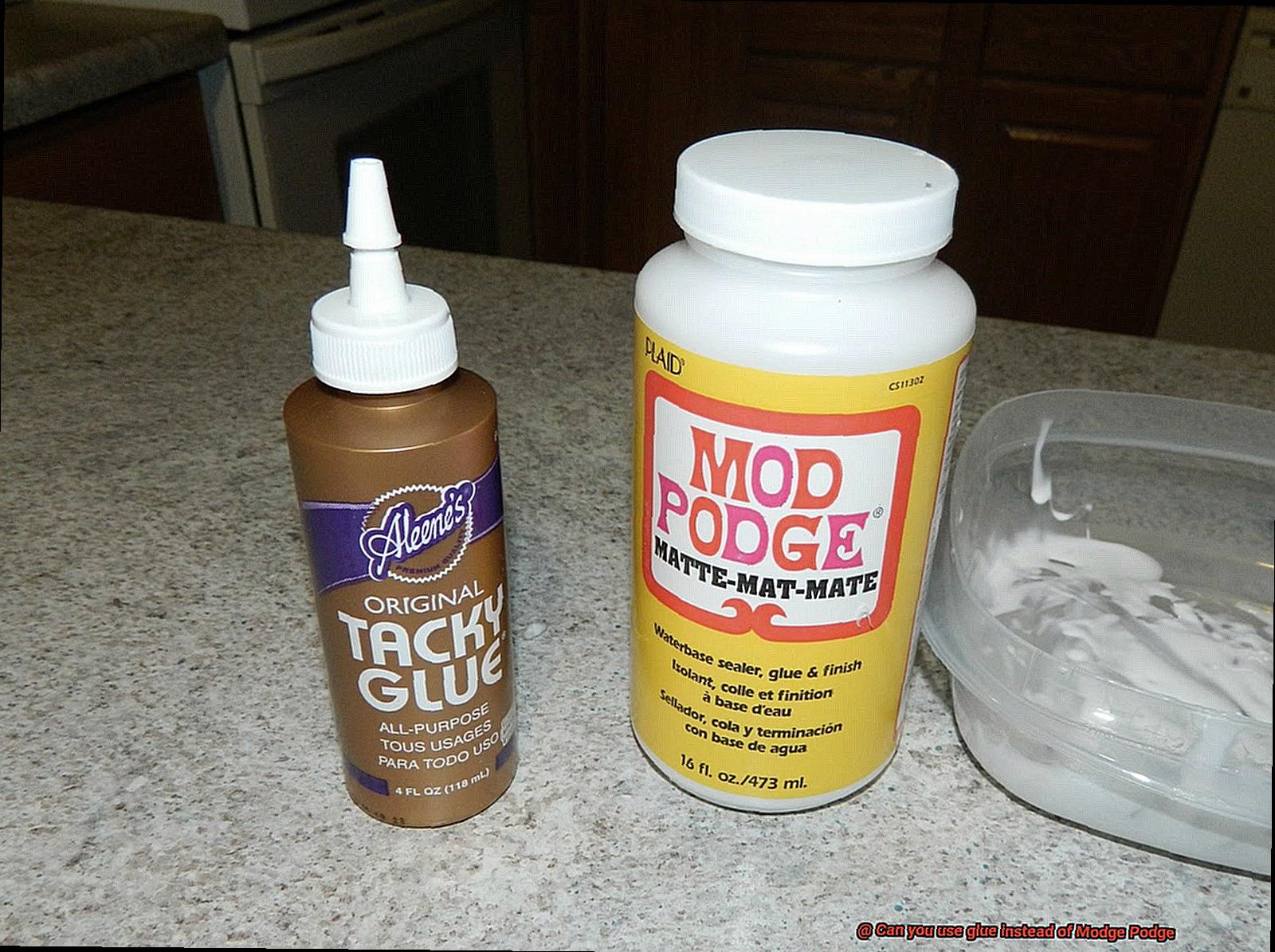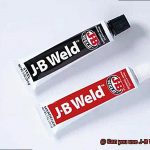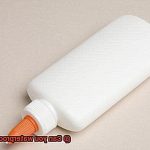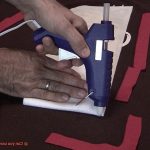Are you a DIY enthusiast who loves to flex your creative muscles with impressive crafts and art projects? If so, you’re probably familiar with Modge Podge – the holy grail of crafting essentials that seals, decorates, and protects a wide range of materials. But what if you find yourself in a sticky situation without any Modge Podge on hand? Can regular glue be used as a substitute?
This seemingly simple question is actually more complex than it appears. In this blog post, we’ll delve into the world of crafting and explore whether glue can replace Modge Podge. We’ll examine the similarities and differences between these two substances and see what happens when you switch between them mid-project. Additionally, we’ll take a closer look at various types of glue and their unique properties, so you can make an informed decision about which one would work best for your project.
Whether you’re new to crafting or an experienced pro, this post is for you. Get ready to discover the world of crafting substitutions and find out if glue can bring the same stellar results as Modge Podge. So let’s not waste any more time – dive in with us and explore the possibilities.
What is Modge Podge?
Contents
Developed in the 1960s by Jan Wetstone, an interior designer, Modge Podge is a water-based sealer, glue, and finish that has become a staple in the crafting world.
This versatile product comes in various formulations, including gloss, matte, satin, and outdoor. The gloss version creates a shiny finish, while the matte version provides a flat finish. If you prefer something in between, the satin version has a slight sheen. For those working on outdoor projects, the weather-resistant outdoor version is ideal.
Modge Podge is not just a glue – it’s also a sealer that can protect your project from damage. It can securely attach paper, fabric, or other materials to any surface with ease. Its thicker consistency compared to regular glue makes it easier to control and spread. Additionally, Modge Podge dries clear and glossy, providing a professional-looking finish that won’t yellow over time.
One of the best things about Modge Podge is its ease of use. Simply apply it with a brush or sponge and let it dry for 15-20 minutes. Once dry, your project will have a durable finish that can withstand wear and tear.
It’s important to note that while regular glue may be used as an alternative to Modge Podge in some instances, it may not provide the same level of durability or finish. Modge Podge is water-resistant and can handle exposure to moisture or handling.
Can You Use Glue Instead of Modge Podge?
While it may seem like a quick fix, using regular glue may not always be the best substitute for Modge Podge. Let’s delve into the reasons why.
Modge Podge is a water-based sealer, glue, and finish that was specifically created for crafting. It contains polyvinyl acetate (PVA), which makes it more adhesive and durable than regular white glue. Additionally, it has a sealer component that protects your project from moisture and wear over time. Regular glue may not have these same properties and could cause your project to wrinkle or curl over time.
Furthermore, the finish of the glue is an important factor to consider. Modge Podge dries clear and glossy, giving your project a professional, polished look. In contrast, regular glue may dry with a matte or cloudy finish that could negatively impact the overall appearance of your project.
While regular glue may be suitable for some projects, it’s critical to consider the specific requirements of your project before substituting Modge Podge. If you’re working on a decoupage project or something that will be exposed to moisture or heat, using regular glue instead of Modge Podge could lead to disastrous results.
Advantages of Using Modge Podge
As an expert in the field, I can confidently say that the advantages of using Modge Podge are numerous and worth the investment.
Firstly, Modge Podge is incredibly versatile. It can be used on virtually any surface, including paper, fabric, wood, metal, and more. Whether you’re making a collage or decoupaging a piece of furniture, Modge Podge has got you covered. Its versatility makes it a go-to material for crafters who want to experiment with different mediums and techniques.
But that’s not all – Modge Podge is also incredibly durable. Once it has dried, it creates a strong bond that is resistant to water and other elements. This means you can use it for projects that will be exposed to the outdoors or handled frequently without worrying about it falling apart. Its durability makes it a reliable choice for any project.
What’s more, Modge Podge comes in a variety of finishes, including matte, gloss, and satin. This allows you to choose the perfect finish for your project and add a professional touch to your work. With its variety of finishes, Modge Podge allows you to customize your projects even further.
Disadvantages of Using Regular Glue
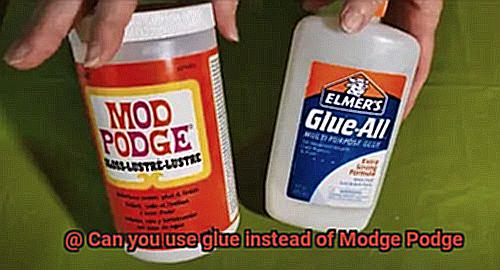
While regular glue may seem like a cost-effective alternative to Modge Podge, it can come with some significant disadvantages to keep in mind.
Firstly, regular glue may not have the same adhesive properties as Modge Podge. This means that your project may not stick together as well or for as long as it would with Modge Podge. Nobody wants their hard work falling apart after a short period of time. The last thing you want is to spend hours creating something only for it to fall apart because you used the wrong kind of glue.
Another disadvantage of using regular glue is that it may not dry clear. If you’re working on a project that requires transparency or a clear finish, regular glue may dry with a yellowish tint. This can be unsightly and ruin the overall effect of your project. You don’t want your clear glass vase to turn yellow over time because of the glue used to hold it together.
Moreover, regular glue may not be as versatile as Modge Podge. Modge Podge can be used for a wide variety of projects and materials, including paper, fabric, and wood. It also comes in different finishes such as matte, glossy, and satin. Regular glue may not work as well on certain materials or give you the same range of finishes to choose from. You don’t want to limit your creativity by using a glue that won’t work on certain surfaces.
Lastly, regular glue may not be as durable as Modge Podge. Modge Podge is designed to withstand wear and tear over time, making it ideal for projects that will be handled frequently or exposed to the elements. Regular glue may not hold up as well under these conditions and could cause your project to fall apart or become damaged. If you’re creating something that you want to last for years to come, using Modge Podge is the way to go.
Diluting Regular Glue to Achieve a Thinner Consistency
Fear not, because you can achieve the same thinner consistency with regular glue. Diluting regular glue is a common practice among crafters who want an affordable alternative to Modge Podge.
To dilute regular glue, you need to mix it with water. The ratio of glue to water depends on the type of glue and the consistency you want to achieve. A 1:1 ratio of glue to water is a good starting point, but feel free to adjust as necessary until you reach your desired effect.
However, not all types of glue are suitable for diluting. Be sure to read the label and instructions before attempting to dilute any glue. Some types of superglue or epoxy glues may lose their adhesive properties when mixed with water.
Once you have diluted your regular glue, it can be used in a similar way as Modge Podge. You can use it on various surfaces such as paper, fabric, wood, and more as a sealant, adhesive, or finishing coat. Keep in mind that the drying time and finish may differ from Modge Podge since diluted glue may dry faster or have a different texture.
Adding a Layer of Clear Sealant or Varnish on Top of Your Project
No need to panic. You can still achieve that protective layer of clear sealant or varnish by using glue instead. As an expert on this topic, let me guide you through the process of using glue as a sealant or varnish for your crafting project.
Firstly, not all types of glue are suitable for this purpose. To achieve the desired results, you need to use a glue that dries clear and has a strong hold. White school glue is one of the most commonly used types of glue for this purpose. Clear-drying PVA glue is also popular in crafting projects.
Once you’ve selected your glue, apply it thinly and evenly over the surface of your project. A brush or sponge can be used depending on the size and shape of your project. Make sure to let the glue dry completely before handling or displaying your project.
While using glue as a sealant or varnish can save you money, it’s important to note that it may not provide the same level of protection as Modge Podge. Glue may not be as durable and may yellow over time. If you’re working on a project that requires long-term protection, Modge Podge may be the better choice.
Cwoi5CEQ9IU” >
Also Read: Is there a Mod Podge Alternative? – Glue Things
Conclusion
In summary, while glue can be a substitute for Modge Podge in certain situations, it may not always offer the same level of durability or finish. Modge Podge is specifically designed for crafting and contains polyvinyl acetate (PVA), which makes it more adhesive and durable than regular white glue. Moreover, its sealer component protects your project from moisture and wear over time. In contrast, standard glue may lack these properties, resulting in a wrinkled or curled project.
Modge Podge is an incredibly versatile tool that works on almost any surface including paper, fabric, wood, metal, and more. It comes in different finishes such as matte, glossy, and satin to suit your preference. Its durability makes it an ideal choice for projects exposed to outdoor elements or frequent handling.
If you are looking to achieve a thinner consistency with regular glue or use it as a sealant or varnish for your crafting project, make sure to select a clear-drying PVA glue or white school glue that has a strong hold. However, keep in mind that using glue instead of Modge Podge may not provide the same level of protection in the long term.
Ultimately, when deciding whether to use glue instead of Modge Podge for your crafting projects, consider the specific requirements of your project before making a substitution.

